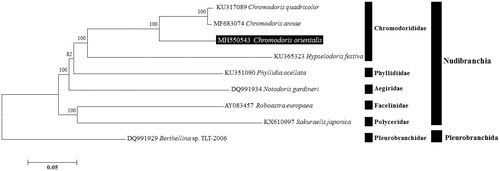Abstract
The mitogenome sequence of sea slug, Chromodoris orientalis (Nudibranchia, Chromodorididae), has been decoded for the first time by coverage genome sequencing method. The overall base composition of C. orientalis mitogenome is 30.5% for A, 14.7% for C, 18.0% for G and 36.9% for T, and has low GC content 32.6%. The assembled mitogenome, consisting of 14,266 bp, has unique 13 protein-coding genes, 22 transfer RNAs, and two ribosomal RNAs genes. The C. orientalis mitogenome has the common mitogenome gene order and feature of Nudipleura (a clade of sea slugs and sea snails). The complete mitogenome of C. orientalis provides essential and important DNA molecular data for further phylogenetic and evolutionary analysis for sea slugs and sea snails.
The genus Chromodoris Alder & Hancock, 1855 contains 62 species that is widely distributed throughout the global oceans, including the temperate, tropical, and the Antarctica waters (Rudman Citation1983; Xiang et al. Citation2016; Lin et al. Citation2017; MolluscaBase Citation2018). Far Eastern waters including Korea and Japan are considered to be the origin of C. orientalis so that this species is called an oriental sea slug and they are currently expanding its range of geographical distribution to the Hong Kong sea areas (Hong et al. Citation2006). In this study, we determined the complete mitochondrial genome of C. orientalis, fourth in the genus Chromodoris.
Specimens of C. orientalis, collected from a SCUBA diving of rocky subtidal, in Uljin-gun, Gyeongsangbuk-do, East Sea of Korea. The voucher specimen was deposited in National Marine Biodiversity Institute of Korea (MABIK MO00171931). The genomic DNA was extracted from the muscle tissue by DNeasy Blood & Tissue Kit (QIAGEN) and its protocol. The mitogenome sequences were analyzed by application of Illumina Hiseq2000 sequencing platform (Macrogen, Seoul, Korea). These sequences were annotated in comparison with mitogenome sequences of species belonging to the order Nudibranchia previously reported by Lin et al. (Citation2017) using Geneious 9.1.8 (Kearse et al. Citation2012). Additionally, we used the mitochondrial genome annotation (MITOS) server (Bernt et al. Citation2013) and tRNAscan-SE server (Lowe and Chan Citation2016) for annotation. Neighbor-Joining (NJ) analysis was constructed using K2P model in MEGA6 (Tamura et al. Citation2013) and dataset were used nucleotide sequences of 13 protein coding genes (PCGs).
The circular mitogenome of C. orientalis is 14,266 bp in length (GenBank accession number MH550543) with 13 PCGs, two ribosomal RNAs (rRNAs), and 22 transfer RNAs (tRNAs). The mitogenome of C. orientalis has a high A + T content (67.4%) similar to the other Chromodoris species (A: 30.5%; C: 14.7%; G: 18.0%; T: 36.9%). 11 PCGs (cox1, nad6, nad5, cob, cox2, atp8, atp6, nad3, nad4, cox3, and nad2) get off by the typical ATG start codon, but two PCGs (nad1 and nad4l) use ATT and ATA as start codon, respectively. Eight PCGs (cox1, nad6, nad4l, cox2, atp8, atp6, nad3, and nad4) use TAA for the stop codon and five PCGs (nad5, nad1, cob, cox3, and nad2) ends with TAG. The lengths of tRNA genes range from 56 to 70 bp and all tRNAs have the typical clover leaf structure except two tRNASerUCN and tRNASerAGC reduced DHU arm.
As a result of confirming the molecular phylogenetic position about this species was closely related to other Chromodoris species and was grouped within family Chromodorididae (). The mitogenome of C. orientalis will be useful for inferring the phylogenetic relationships among the members of Chromodorididae within the Nudibranchia.
Figure 1. Neighbor-Joining (NJ) tree based on the protein coding genes (PCGs) of Chromodoris orientalis and other sea slugs under order Nudibranchia. Berthellina sp. derived from Pleurobranchida was used as outgroup for tree rooting. Numbers above the branches indicate NJ bootstrap values from 1,000 replications.

Disclosure statement
The authors declare that they do not have any conflict of interest. The authors alone are responsible for the content and writing of the paper.
Additional information
Funding
References
- Bernt M, Donath A, Jühling F, Externbrink F, Florentz C, Fritzsch G, Pütz J, Middendorf M, Stadler PF. 2013. MITOS: improved de novo metazoan mitochondrial genome annotation. Mol Phylogenet Evol. 69:313–319.
- Hong SY, Park KY, Park CW, Han CH, Suh HL, Yun SG, Song CB, Jo SG, Lim HS, Kang YG, et al. 2006. [Marine Invertebrates in Korean Coasts]. Seoul: Academy Publishing Company, Inc.
- Kearse M, Moir R, Wilson A, Stones-Havas S, Cheung M, Sturrock S, Buxton S, Cooper A, Markowitz S, Duran C, et al. 2012. Geneious Basic: an integrated and extendable desktop software platform for the organization and analysis of sequence data. Bioinformatics. 28:1647–1649.
- Lin GM, Xiang P, Sampurna BP, Hsiao CD. 2017. Genome skimming yields the complete mitogenome Chromodoris annae (Mollusca: Chromodorididae). Mitochondr DNA B. 2:609–610.
- Lowe T, Chan P. 2016. tRNAscan-SE On-line: Integarating search and context for analysis of tranfer RNA genes. Nucleic Acids Res. 44(W1):W54–W57.
- MolluscaBase. 2018. Chromodoris Alder & Hancock, 1855. World Register of Marine Species. http://www.marinespecies.org/aphia.php?p=taxdetails&id= 137782 on 2018-07-02 [accessed 2018 Jul 02].
- Rudman WB. 1983. The Chromodorididae (Opisthobranchia: Mollusca) of the Indo-West Pacific: Chromodoris splendida, C. aspersa and Hypselodoris placida colour groups. Zool J Linn Soc. 78:105–173.
- Tamura K, Stecher G, Peterson D, Filipski A, Kumar S. 2013. MEGA6: Molecular Evolutionary Genetics Analysis Version 6.0. Mol Biol Evol. 30:2725–2729.
- Xiang P, Lin M, Zhao L, Shen KN, Hsiao CD. 2016. Low-coverage genome sequencing yields the complete mitogenome of Pyjama slug, Chromodoris quadricolor (Mollusca: Chromodorididae). Mitochondr DNA B. 1:94–95.
